

I have chosen to study my hometown, Appleton Wisconsin. I grew up walking along the Fox River, which flows directly through town. Signs line the river in popular fishing spots, warning about health hazards related to consumption of fish.

The Fox River has PCB, or poly-chlorinated biphenyl, contamination which has been released into the river over the course of many decades from the many pulp and paper mills that have historically lined the river, some just south of Appleton (ATSDR 2006). PCB contamination has been found to impact surrounding communities most directly through consumption of fish from the Fox River. Hmong, Native American, African American and Hispanic communities, have been shown to be most susceptible to contamination of PCBs through consumption. This is due to both reliance on fish as a food resource in these communities as well as less awareness of the dangers of consumption. Ingestion and exposure to PCBs can inhibit reproductive abilities, brain and immune system function, and can cause cancer. These health impacts are shown to be most potent to children (CDC). The exposure of high levels of PCBs to specific communities is an unjust sustainability because specific racial and ethnic groups are exposed to PCBs at disproportionate levels and so are disproportionately impacted by the health and financial strains caused by PCB contamination.
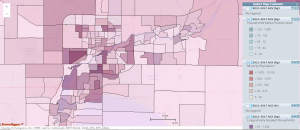
The children of these communities are also unjustly impacted by inhibited neurological function, due to PCB contamination, which disproportionately disadvantages them cognitively. These communities also have higher rates of poverty which makes accessing treatment for potential health ramifications from PCB contamination as well as ability to choose other food sources even more challenging. Hmong populations in Appleton are also highly linguistically isolated which has been shown to inhibit awareness of PCB contamination of fish and potential health hazards, as well as limits ability to seek medical care and other necessary aid. All of these factors are interconnected and further intensify each other, clearly disproportionately harming minority communities over others.
My visual is made out of recycled t-shirts, all of which I wore on runs with my high school cross country team. Our team had a tradition of jumping into the Fox river at the end of runs to cool off. This undoubtedly exposed us and our clothes to the PCB contaminated water. Although contamination is most likely to cause health problems when ingested, these shirts represent the everyday exposure to PCBs in the city of Appleton. I placed this representation of Appleton and the Fox River on a piece of paper that shows transportation and so ultimately affluence, to represent the choice, or lack thereof, in regard to diet and health impacts. The visual is also framed by a cut out egg carton, to represent choice surrounding food, and by pill bottle caps, to represent the cost both literally and physically that PCB contamination through consumption can cause, in the potential need for medical care.
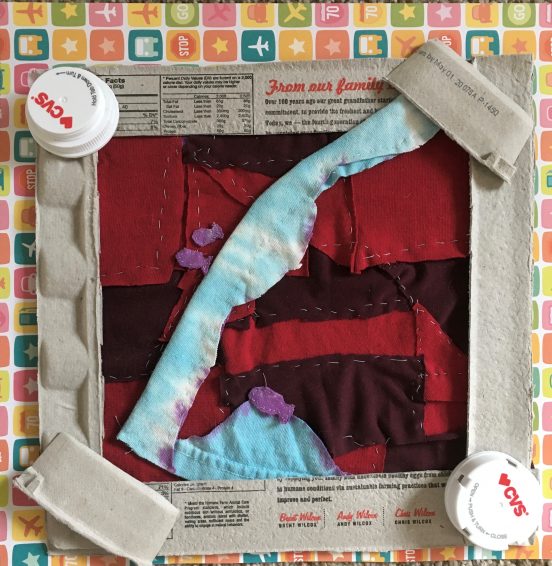
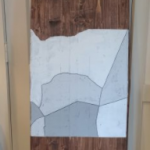

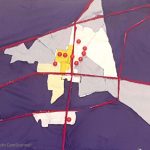
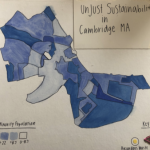
Matthew Stoneking
May 1, 2020 — 5:38 pm
This is a nice piece! Thanks for sharing. I know there have been dredging projects on parts of the Fox River. I am not sure what the impact of putting contaminated dredged material in landfills, but I imagine there can be risk to groundwater.
Kathryn
May 1, 2020 — 5:47 pm
Thank you! Yea, so there have been some attempts and are ongoing projects to remove PCBs, which latch onto other organic materials, like sediment, hence the dredging, from the Fox and that efforts have been made to prevent further contamination throughout the dredging process, but yea I am sure that we will continue to see effects of PCB contamination from these landfills as well, particularly because PCBs take a really long time to break down…
meltmarr
May 1, 2020 — 5:41 pm
The Hmong people are an ethnic group native to several countries including China. The Hmong rely on the Yangtze river for a lot of their food. Do you think thats why they fish so much in the fox river and due to the fact that a lot of them are low income?
Kathryn
May 1, 2020 — 5:52 pm
Yea, so from what I have read in my research, the tradition of subsistence farming and fishing has had a big influence on dietary habits in Hmong communities, including communities in Appleton. And that particularly most Hmong residents in the Appleton/Green Bay area live within the city making other forms of self-grown/home-grown food more difficult which has lead to such high reliance on fish consumption. This reliance is also exacerbated by high levels of poverty among these communities
levinana
May 1, 2020 — 5:51 pm
I love your use of materials Kathryn! The running shirts serve as such a cool way of making the issue personal. Are there any initiatives your community is currently implementing to protect the rights of the Hmong people?
Kathryn
May 1, 2020 — 5:56 pm
Thank you! So from what I have read, it seems like there have been efforts, especially in Green Bay, which is about 30 minutes north east of Appleton, to increase literacy among Hmong populations, because prior to about 40 years ago, Hmong was an oral language and so many older Hmong residents cannot read the signs posted along the river that warn of health hazards from fish consumption. There have also been some educational events with Hmong translators to help make the community more aware of this issue.
messimeg
May 1, 2020 — 6:10 pm
I love this visual! Using old tee shirts to connect your personal experience to the environmental bad is such an original idea. I also think that tying every aspect of the visual into how it relates to the environmental injustice is really thoughtful.
gamzan
May 1, 2020 — 6:16 pm
Great way to tie personal experience into your project by using old materials that went into the river! It’s a good way to show just how many people this env bad could eventually impact.
Anna
May 1, 2020 — 6:16 pm
Wow, very strong project! I was wondering if you knew about this unjust sustainability before you began your research, or if it somewhat of a hidden truth in the area?
Kathryn
May 1, 2020 — 6:35 pm
Thank you Anna! Yea I learned about it very briefly in my environmental science class in high school, but I hadn’t really known too much about it before then. And despite the signs along the river, if you’re not super observant or that’s not your focus I think it would be really easy to live in Appleton you’re whole life and not even know about the full extent of PCB contamination. But I don’t think anyone is trying to actively hide it. There are stories in the local paper about the clean-up efforts.
burkea
May 1, 2020 — 6:18 pm
Hi there! I love this project- you did a great job of connecting your personal story to the issue, as well as your visual project! (The t-shirts were an excellent choice!) I was wondering if you know of any efforts to remove the PCB from the river? Are there any species that can be introduced into the river that might remove the chemical naturally?
Kathryn
May 1, 2020 — 6:38 pm
Thank you so much! I don’t think there are any species that could remove the species naturally because PCBs tend to bind to organic materials and don’t break down for a really long time, but that is an interesting idea and I will for sure look into it! And yea there have been dredging efforts where they’ve gone in and removed some of the contaminated sediment but even that as was mentioned in an above comment has it’s potential dangers to groundwater and soil contamination.
Laura Smythe
May 1, 2020 — 10:13 pm
I love the materials you used to highlight this issue! Are all/any of the signs posted on the Fox River in Hmong as well as English?
Sooik
May 2, 2020 — 3:53 am
Wow! I really like your visual made out of your old t-shirts. That’s quite original. Also very thorough explanation about PCB contamination and how it affects the Hmong people disproportionately. My project is also about how water contamination affects certain communities, and for me, it was quite difficult to find the data related to health outcomes specifically from those communities. Were you able to find any data/information that shows the higher cancer rate or risk of other health conditions in the Hmong community?